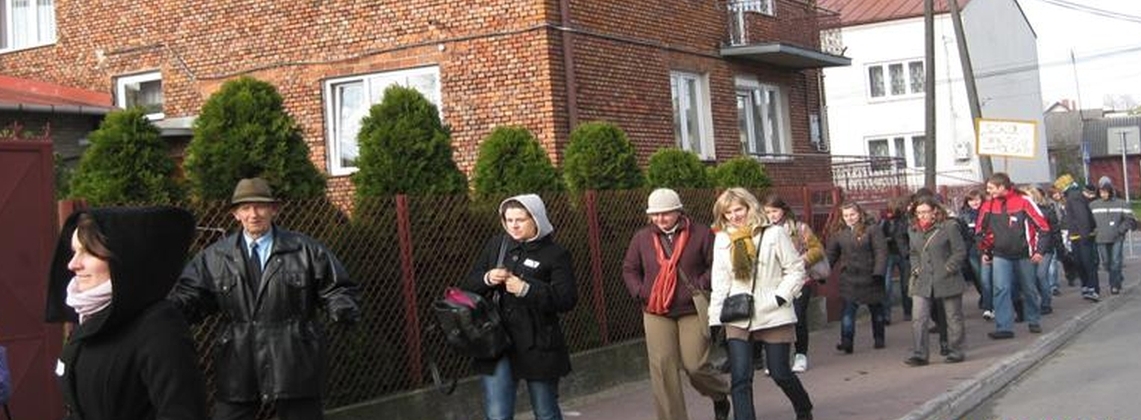| 2010 |
Radoszyce
Kazimierz Wielki Junior High School No 1


| 2010 |
1st Award at 2010 School of Dialogue Gala
Continuing School of Dialogue in 2015
When looking at a yellowed photograph of 1938 Radoszyce, it is difficult to recognise the contemporary town. Students from Kazimierz Wielki Junior High School no. 1 are bending over pre-war photographs. Someone points to the familiar steeple of the St Peter and Paul church in the background. The Forum for Dialogue educators are trying to describe Radoszyce’s pre-war realities. They talk about the Jewish inhabitants who lived in Radoszyce from the 16th century and comprised 38% of the town’s population in 1921. They talk about the Jewish houses in the town square, about the synagogue and the mikveh in Ogrodowa Street where the police station stands today. They describe the Meeting House of the Jewish Council, the cheder, Rojcman’s malt water bottling plant, the Jewish bakery, and the surgeon’s business. Another photograph: the town square in Radoszyce, 1938. In 1944, most of the town’s buildings burnt down as a result of guerrilla battles. If not for the caption it would be difficult to recognise it as the current square in Radoszyce’s centre.
Ania says, “I’ve lived here for 15 years and I’m surprised how little I know about what was happening in Radoszyce several dozen years ago.” However, the photographs they see and the tales they hear during the School of Dialogue workshops slowly let the students form an image of the old Radoszyce. They start to talk to their grandparents about the Jews who lived in the town before the war, and they interview the older inhabitants of Radoszyce and Jamikowice. They discover that the neighbourhood known as “Kierkowo” are the premises of the Jewish cemetery, locally called “kierkut”.
On October 28, the students invite the school community, their teachers, a priest and an elderly citizen who will tell everyone about the old life in the multicultural Radoszyce to a walking tour entitled “Shalom, Radoszyce”. Earlier they print the invitations and place a menorah and pre-war photographs in the school’s main hallway.
They borrow a loudspeaker from the priest. They prepare a board saying “School of Dialogue – Poland”. The boys bring yarmulkes to cover their heads while at the cemetery. Martyna is carrying a challah in her basket to share with everyone later.
The students and a fairly large group of teachers gather at the school’s entrance. Paweł presents the town’s historical background, and afterwards everyone goes for a walk. Someone is taking photos, someone else is offering a microphone, another person is showing old photographs. The students point to the premises of the ghetto, the Umschlagplatz, and Esterka’s house. Some passers-by stop, listen and then join for a moment. The group moves on to the former rabbi’s house and the cheder. Alicja, Kasia and Magda talk about the history of the wooden synagogue that’s no longer there. The students present a photograph from the wedding of a local tzaddik. Next, the group walks to the town square. The participants look at a 1935 photograph showing the house of Reszlbuch Szlama and they listen to Mr Relidzyński’s stories about the town square.
Close by is the place where Perec’s library used to be, and further on are the premises where Rojcman’s soda water bottling plant and brewery was located. Mr Relidzyński recalls the wonderful taste of the orange soft drink from the bottling plant that he used to drink when he was a child. Next, everyone goes to the spot where the Jewish bakery used to be. Mr Mastelarz used to work there, and his grandson, who owns the bakery now, shares his memories with the students. He tells everyone how he used to help his grandfather bake challah for the town fairs and he points to the building in which the bakery’s owner used to live. Today, he is still using the recipes he received from his grandfather. At the walk’s next stop the Jewish cemetery’s caretaker tells everyone about the cemetery and she offers the keys to the cemetery gate and to the ohel of a tzaddik. At the cemetery Małgosia reads the names of the Jews who lived in Radoszyce before World War 2. They will be listed in the “Memory Trees” drawn by the students. Now, the young people know a lot more about the roots of their town and the history of Radoszyce in which each Friday challahs were baked and Sabbath was celebrated.
I think that the School of Dialogue is an excellent way to learn history and get to know other cultures; it teaches us how to tolerate and accept them, it gives us a new way of looking at the world, and it allows young people to share the newfound knowledge, experiences and impressions with others.
Ewelina, workshops participant
Now I know the history that happened on the streets of my town. I understood that these atrocities occurred only 70 years ago, that these people lived in this or that square, that those who knew them personally are still alive. It speaks to me only now and when I think of it, I am shocked… I believe everybody should know about it.
Ewa, workshops participant

School:
Kazimierz The Great Junior High School No 1
Honorable Mention:
1st Award at 2010 School of Dialogue Gala
Continuing School of Dialogue in 2015
Students:
1st-3rd year students
Teacher:
Barbara Tkacz
Expert:
Robert Nowak
Educators:
Anna Maculewicz, Zuzanna Wiaderna
School of Dialogue program in Radoszyce was made possible by the support from NANCY and CHRISTOPHER WINSHIP.
In appreciation to Friends of the Forum for supporting the School of Dialogue educational program.
